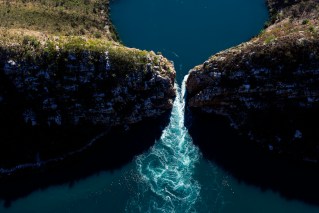Guests or invaders? World’s beauty spots being plagued by too many tourists

Two Italian towns have started restricting visitors to prevent overcrowded beaches this summer, with one village even banning beach towels.
In Baunei, on the Italian island of Sardinia, a daily cap on visitors has been put in place. The cap differs depending on the beach, with one beach implementing an entrance fee.
To visit the beaches tourists must book through an app called ‘Cuore di Sardegna’ at least 72 hours in advance.
The natural beauty of Sardinia’s beaches have attracted plenty of tourists in the summer months, which is why the cap was necessary.
Mayor of Baunei, Stefano Monni, told CNN the beaches could no longer afford to have thousands of tourists flock there every day, saying it was simply “not sustainable”.
“We must protect this paradise and its fragile ecosystem,” Mr Monni said.
About a three-hour drive away from Baunei, on Sardinia’s north-west coast is La Pelosa in Stintino, where in addition to a cap on visitors, the local authorities have banned beach towels.
Stintino’s mayor Rita Limbania Vallebella told CNN how tourists left behind rubbish which she claimed led to sand erosion.
Instead of beach towels, which collect sand, people must use mats, while dogs and smoking are banned.

Beach towels are banned at La Pelosa in Italy. Photo: Getty
While booking a beach trip days in advance and foregoing a beach towel might seem outrageous to Australians, experts are quite impressed.
RMIT’s Dr Rebecca Olive studies the role of leisure in human environmental health and wellbeing. She said while she worries the caps and fees will only permit the wealthy to access some of the most beautiful beaches in Italy, she gets it.
Unlike in Australia, where beachside parking may be the only expense, it’s culturally different in Europe and not so outlandish to pay in order to visit a beach.
Her research acknowledges how being by the coast can positively benefit health and wellbeing, but that our actions have consequences.
“There’s this real tension between both promoting the beach as the place of health, wellbeing and leisure, and managing the effects on the beach,” Dr Olive said.
“As we destroy beaches, the health returns for us are going to be less.”
Eco-tourism and over-tourism
Dr Freya Higgins-Desbiolles lectures in tourism management at the University of South Australia and she says “eco-tourism” has a very precise definition.
“It involves travel to natural places to experience the environment and then it has these facets to it, which are required: conservation, education and care for the environment,” she told The New Daily.
Dr Higgins-Desbiolles said she was really impressed by the range of actions Baunei and Stintino are taking.
The concept of over-tourism is new, and it refers to when a place exceeds its capacity and there are negative impacts on the environment and the local community.
Over-tourism can lead to pollution and litter, make essentials scarce and cause locals to be unhappy.
Regulations like what Italy is introducing will likely become more common in the near future, Dr Higgins-Desbiolles said.
“Now we’re in this period where there’s a really strong demand and I guess we can expect that over-tourism is going to be with us for a while,” she said.
Regulation through limits and controls can be one way to prevent over-tourism, but that can be difficult. And sometimes local authorities don’t actually want to deter visitors.
Italy isn’t the only place that has been forced to act due to environmental destruction caused by excessive tourism.
Maya Bay in Thailand was closed for a period for the sake of conservation, as was Fjaðrárgljúfur Canyon in Iceland due to excessive foot traffic leading to vegetation and trails being damaged.

Maya Bay in Thailand also had to turn away tourists due to conservation concerns.
Effects on communities
Over-tourism doesn’t just affect the environment, it can also harm the local community.
Dr Higgins-Desbiolles grew up on an island off the coast of North Carolina, which over time became a tourist hotspot. While tourists led to more amenities on the island, over time it became too expensive for the locals to live there.
“The worst thing that tourism can do is it displaces local people,” she said.
Dr Olive once lived next door to her grandmother in Byron Bay, and when that house was sold it was turned into a holiday home. In her own experience, it was bad for the community because she no longer had neighbours to rely on.
Dr Higgins-Desbiolles said eco-tourism and sustainable tourism should take into consideration how the local communities can benefit and thrive.
“I think the tourism experience really benefits when you’re an invited, welcomed guest, rather than a damaging invader, which is one way we could see it,” she said.
Damaged communities
“By centring on the local community, I think you get a real pathway for a more respectful phenomenon.”
Governments and local authorities have the power to put in restrictions or rules to prevent over-tourism.
But industry can put pressure on the government to prevent safeguards from being put in place.
In some cases, it has been the locals who have encouraged action. In Venice, cruise ships were barred from docking after locals protested.
Some responsibility also needs to fall on tourists.








